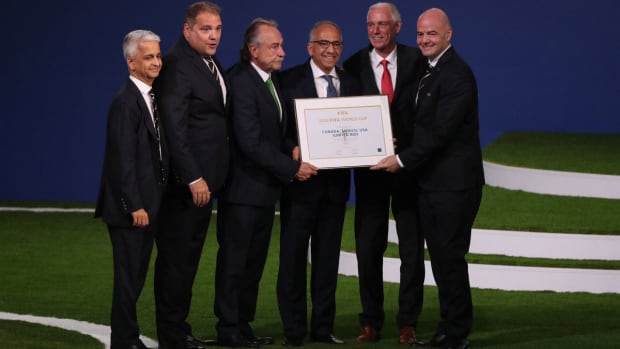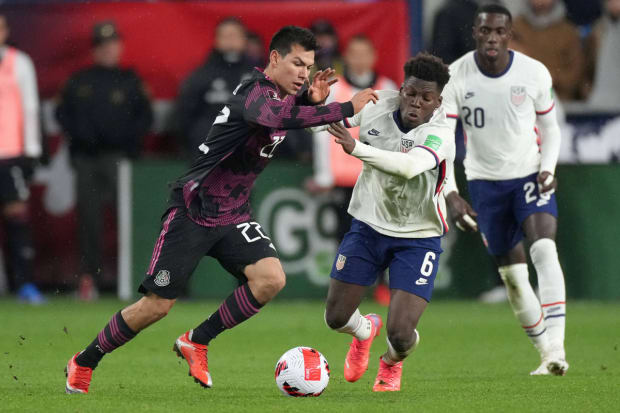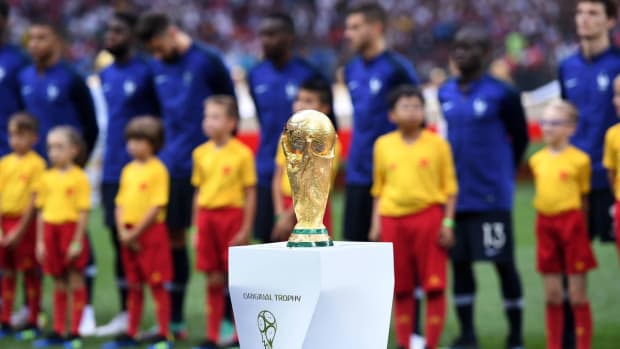There’s a decent chance that when the men’s World Cup makes its way to North America in 2026, with its field expanded from 32 to 48 teams, locals will be introduced to a bit of suddenly relevant old soccer lore. The famed “Disgrace of Gijón” remains a 90-minute cautionary tale of how significantly tournament scheduling and structure can impact results.
Gijón is a coastal city in northwest Spain, and the disgrace was perpetrated there during the 1982 World Cup. That 24-team tournament—where the first round started with six groups of four—allowed only two African entrants, and one of them, Algeria, stunned West Germany, 2–1, in the opener. No African nation had ever advanced at a World Cup, but by the time the group stage was concluding, Algeria remained in the hunt with the West Germans and Austria for one of the group’s prized two spots in the second round.
The problem was that Algeria had already finished its group-stage schedule when the other two teams kicked off their final game, in Gijón, and the neighbors knew what was required to go through at Algeria’s expense. Horst Hrubesch’s 10th-minute goal lifted West Germany to a 1–0 lead, and that was it. The rest of the game played out like that farcical scene in The Simpsons.
Cut to Kent Brockman: “Halfback passes to the center, back to the wing, back to the center. Center holds it, holds it, holds it ...”
Austria’s actual commentator, Robert Seeger, famously told viewers to turn off their TVs.
All three nations finished group play with two wins and a loss, but Germany and Austria advanced on goal differential. FIFA rejected Algeria’s protest—no rules had been broken. But reforms followed that persist to this day, reducing the likelihood of conspiracy or chicanery in soccer tournaments and leagues across the world. Most notably, group-stage (or regular-season) finales would kick off simultaneously.
But that may not persist into 2026, as the influx of teams will require a format shake-up. For FIFA, the definition of fairness has evolved.

The Sporting Press
There were the two African sides at the 1982 World Cup, and just one four years earlier. And Asia, the planet’s most populous continent, somehow received only one ticket to Spain. The World Cup was barely that, and, as soccer went global, access had to evolve.
Sixteen years after Gijón, FIFA finally seemed to find the happiest medium. France 1998 featured 32 teams—17 from outside Europe—and a generally agreeable balance between inclusion and quality. Nobody was blown out. Everybody belonged. The tournament format itself was square, symmetrical and satisfying: eight groups of four teams each, with the top two finishers in each advancing to the knockouts. There were no wild cards or third-place reprieves, and every contender had the same, seven-game path to the title. And yes, group-stage finales were played at the same time. After decades of tinkering, it felt like FIFA had found its ideal format. It remained largely unchanged for the next six World Cups.
World Cup 2022: Schedule and TV coverage.
But growth is inevitable—or at least the desire for it is. The NFL, MLB, NBA, MLS, NWSL and Mexico’s Liga MX have all increased their playoff fields in recent seasons. The size of the College Football Playoff is going to triple. Overseas, men’s continental championships in Europe, Africa and Asia all now feature 24 national teams, while UEFA’s club competition overhaul includes a Champions League enlarged from 32 to 36 teams starting in 2024, as well as the Europa Conference League, a lower-tier tournament created last year. More participants and more product mean more investment, sponsorship and TV revenue.
“We are in the 21st century, and we have to shape the World Cup of the 21st century,” FIFA president Gianni Infantino said in early 2017. “The football fever that you have in a country that qualifies for the World Cup is the biggest promotional tool for football that you can have.”

Xu Zijian/Xinhua/Imago Images
The FIFA Council vote that preceded Infantino’s remarks was unanimous. When the planet’s biggest sporting event balloons to 48 countries in 2026, a significant majority of the additional berths will be allocated outside of Europe. There were a few pockets of resistance among football’s elite, but they were swiftly swept aside.
“I think the number was pretty comfortable,” says Concacaf president and FIFA vice president Victor Montagliani, a Canadian businessman. “Some of the pushback was, you always have the traditionalists who think it should stay where it was. I’m sure some [FIFA] members think it should’ve stayed at 16 until the end of time. That’s not our reality.
“A lot of members have been investing in their development programs, and we thought this was a balance that still kept the exclusivity of a World Cup but also giving people that have been investing and members that hope. That’s one of the things we always have to provide.”
Get SI's World Cup Preview Issue Here
As alarming as the 50% increase seems, Montagliani’s use of “exclusivity” still isn’t entirely off base. FIFA has 211 members—that’s more than the United Nations—so less than 23% of the world’s national teams will make the enlarged World Cup. That’s a far lower percentage than the playoff qualification rates of any of the major North American leagues, and it’s stingier than any of the six continental championships, which are a national team’s secondary target. (The Concacaf Gold Cup is the most exclusive, at 39%.)
Expansion will have an impact on regional qualifying tournaments, which constitute a major portion of the international soccer calendar. South America, for example, has traditionally staged a 10-team double round robin that sends four countries directly to the World Cup (while a fifth typically enters through a playoff).
That marathon would be pointless, however, with the six automatic bids and a playoff place available for 2026. It doesn’t make much sense to schedule 90 matches to eliminate three teams. The same is true in Concacaf, where we’ve likely seen the last of the epic home-and-home qualifiers between the U.S. and Mexico. After automatic qualification in ’26—another upside of hosting—the rivals will probably be seeded in separate groups going forward as the region’s guaranteed World Cup allocation doubles to six.

Robin Alam/Icon Sportswire/Imago Images
The coming overhaul represents a measurable loss of tradition, excitement, jeopardy and revenue. (Individual countries, not FIFA, own the rights to their qualifiers.) Montagliani argues that those deficits will be offset by the inevitable rise of nations that now feel they have a shot at qualification. An attempt to trigger that improvement is already underway in Concacaf. The new Nations League competition, which kicked off in 2019, offers smaller countries a platform to develop. The number of international matches within the region has increased roughly threefold over the past four years, Montagliani says.
“As we move forward beyond 2030,” he argues, “you’re going to see an increase in competitiveness in terms of a lot of our countries, where the pool of teams that can beat each other on any given day is going to get bigger and bigger.”
But what about that singular, magical month that comes just once every four years? Its current structural perfection is, to some extent, being sacrificed upon Infantino’s altar of the “hope.”
There is no square, symmetrical or satisfying way to stage a 48-team tournament. FIFA’s original 80-game group-stage plan—16 groups, three teams each—sets up 16 potential Disgrace of Gijón scenarios, where one team will be finished and the remaining two will know what’s required to advance. Infantino mentioned using penalty kicks during the group stage, or even FIFA’s monthly ranking, as a potential extra tiebreaker that could limit the chance of collusion. Both are gimmicks.

Michael Kienzler/Ulmer/Imago Images
What about 12 groups of four? That would create 24 extra group-stage games and, assuming the new round of 32 is maintained, reintroduce the unwieldy third-place wild cards. The four semifinalists then would be forced to play an unprecedented eight games in 32 to 35 days.
For now, the three-team-groups setup seems likely, despite its inherent flaws. There’s no ideal solution, because FIFA has decided to abandon the ideal format. Infantino promised more, and now he has to manage the crowd. Montagliani says that FIFA, which has had the pandemic and the Qatar World Cup to deal with, will start to dig into the issue next year.
“I think it’s a valid concern. Formats are always a concern,” Montagliani says. “If FIFA feels that it’s in the best interest of the tournament to review this format, I think it’s our fiduciary duty to do it, keeping in mind the same principles have to be in place: It’s got to be good for the tournament. It’s got to be done with the proper sort of dialogue with the stakeholders, and it ensures the tournament stays within the framework—35 or so days.”
So enjoy the final “perfect” World Cup, and keep in mind that it could have been so much worse. Infantino’s effort to demolish the global football calendar and stage a men’s World Cup every two years died on the vine this spring.







